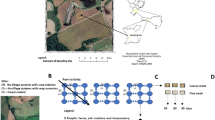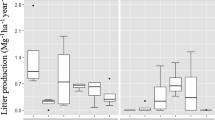Abstract
The response of soil fauna to the litter decomposition process has received considerable attention, but this effect has not been fully examined in agroforestry systems. A 1-year in situ decomposition experiment was carried out in a pure ginkgo plantation and two ginkgo agroforestry systems using a litterbag method (11 different treatments were tested in three systems). We found that the application of different organic materials (crop residues) produced positive effects on the number of soil fauna in the ginkgo planting systems; the mixture of ginkgo leaves and corn leaves was the best performing treatment. Collembola and Acarina were the predominant groups in the litter bags and were mainly responsible for the differences among the treatments. Litter mixing promoted the abundance, richness, and diversity of soil fauna, and significant differences regarding the Shannon–Wiener index of the soil fauna were observed among the 11 treatments in July. Significantly higher soil MBC (microbial biomass carbon) and MBN (microbial biomass nitrogen) were observed in agroforestry systems than in pure ginkgo plantations. These results suggest that the practice of intercrop residue application plays an important role in enhancing soil ecosystem function in ginkgo agroforestry systems and may ultimately contribute to sustainable intercrop production, soil fertility, and local economic diversity.




Similar content being viewed by others
References
Aponte C, García LV, Marañón T (2012) Tree species effect on litter decomposition and nutrient release in Mediterranean oak forests changes over time. Ecosystems 15(7):1204–1218
Bardgett RD, Lovell RD, Hobbs PJ, Jarvis SC (1999) Seasonal changes in soil microbial communities along a fertility gradient of temperate grasslands. Soil Biol Biochem 31(7):1021–1030
Battle M, Bender ML, Tans PP, White JWC, Ellis JT, Conway T, Francey RJ (2000) Global carbon sinks and their variability inferred from atmospheric O2 and δ13C. Science 287(5462):2467–2470
Beer C, Reichstein M, Tomelleri E, Ciais P, Jung M, Carvalhais N, Rödenbeck C, Arain MA, Baldocchi D, Bonan GB, Bondeau A, Cescatti A, Lasslop G, Lindroth A, Lomas M, Luyssaert S, Margolis H, Oleson KW, Roupsard O, Veenendaal E, Viovy N, Williams C, Woodward FI, Papale D (2010) Terrestrial gross carbon dioxide uptake: global distribution and covariation with climate. Science 329(5993):834–838
Belovsky GE, Slade JB (2000) Insect herbivory accelerates nutrient cycling and increases plant production. Proc Natl Acad Sci USA 97(26):14412–14417
Bradford MA, Berg B, Maynard DS, Wieder WR, Wood SA (2015) Understanding the dominant controls on litter decomposition. J Ecol 104(1):229–238
Burton J, Chen CR, Xu ZH, Ghadiri H (2010) Soil microbial biomass, activity and community composition in adjacent native and plantation forests of subtropical Australia. J Soils Sediments 10:1267–1277
Cebrian J (1999) Patterns in the fate of production in plant communities. Am Nat 154(4):449–468
Coûteaux MM, Bottner P, Berg B (1995) Litter decomposition, climate and litter quality. Trends Ecol Evol 10(2):63–66
De Ruiter PC, Moore JC, Zwart KB, Bouwman LA, Hassink J, Bloem J, De Vos JA, Marinissen JCY, Didden WAM, Lebrink G, Brussaard L (1993) Simulation of nitrogen mineralization in the belowground food webs of two winter wheat fields. J Appl Ecol 30(1):95–106
Fujii S, Makita N, Mori AS, Takeda H (2014) Plant species control and soil faunal involvement in the processes of above- and below-ground litter decomposition. ESA Conv 146(10):2013–2018
Goyal S, Chander K, Mundra MC, Kapoor KK (1999) Influence of inorganic fertilizers and organic amendments on soil organic matter and soil microbial properties under tropical conditions. Biol Fertil Soils 29(2):196–200
Guo LB, Sims REH (2002) Eucalypt litter decomposition and nutrient release under a short rotation forest regime and effluent irrigation treatments in New Zealand: II. Internal effects. Soil Biol Biochem 34(7):913–922
Hamman ST, Burke IC, Stromberger ME (2007) Relationship between microbial community structure and soil environmental conditions in a recently burned system. Soil Biol Biochem 39(7):1703–1711
Hargreaves SK, Hofmockel KS (2014) Physiological shifts in the microbial community drive changes in enzyme activity in a perennial agroecosystem. Biogeochemistry 117(1):67–79
Högberg MN, Högberg P, Myrold DD (2007) Is microbial community composition in boreal forest soils determined by pH, C-to-N ratio, the trees, or all three? Oecologia 150(4):590–601
Huang X, Liu S, Wang H, Hu Z, Li Z, You Y (2014) Changes of soil microbial biomass carbon and community composition through mixing nitrogen-fixing species with Eucalyptus urophylla, in subtropical China. Soil Biol Biochem 73(6):42–48
Janssen SL, Persson J (1982) Mineralization and immobilization of soil nitrogen. In: Stevenson FJ (ed) Nitrogen in agricultural soils. Agron Monogr 22 ASA, CSSA, SSSA, Madison, WI, pp 229–252
Jewell MD, Shipley B, Paquette A, Messier C, Reich PB (2015) A traits-based test of the home-field advantage in mixed-species tree litter decomposition. Ann Bot 116(5):781–788
Jin HM, Sun JX, Liu JF (2010) Changes in soil microbial biomass and community structure with addition of contrasting types of plant litter in a semiarid grassland ecosystem. J Plant Ecol 3(3):209–217
Lalor BM, Cookson WR, Murphy DV (2007) Comparison of two methods that assess soil community level physiological profiles in a forest ecosystem. Soil Biol Biochem 39(2):454–462
Lavelle P (1997) Soil function in a changing world: the role of invertebrate ecosystem engineers. Eur J Soil Sci 33(4):159–193
Lummer D, Scheu S, Butenschoen O (2012) Connecting litter quality, microbial community and nitrogen transfer mechanisms in decomposing litter mixtures. Oikos 121(10):1649–1655
Ma XQ, Liu CJ, Hannu I, Westman CJ, Liu AQ (2002) Biomass, litterfall and the nutrient fluxes in Chinese fir stands of different age in subtropical China. J For Res 13(3):165–170
Peña-Peña K, Irmler U (2016) Moisture seasonality, soil fauna, litter quality and land use as drivers of decomposition in Cerrado soils in SE-Mato Grosso, Brazil. Appl Soil Ecol 107:124–133
Reichle E, Mcbrayer JF, Ausmus S (1975) Ecological energetics of decomposer invertebrates in a deciduous forest and total respiration budget. Progress in soil zoology. Academia Publishing House of Slovak Academy of Sciences, Prague, pp 283–292
Sauvadet M, Chauvat M, Brunet N, Bertrand I (2017) Can changes in litter quality drive soil fauna structure and functions? Soil Biol Biochem 107:94–103
Schimel JP, Hättenschwiler S (2007) Nitrogen transfer between decomposing leaves of different N status. Soil Biol Biochem 39:1428–1436
Shah Z, Ahmad RS, Rahman HU (2010) Soil microbial biomass and activities as influenced by green manure legumes and N fertilizer in rice-wheat system. Pak J Bot 42(4):2589–2598
Sharma G, Sharma R, Sharma E (2008) Influence of stand age on nutrient and energy release through decomposition in alder-cardamom agroforestry systems of the eastern Himalayas. Ecol Res 23(1):99–106
Troeh FR, Thompson LM (1993) Soils and soil fertility, 5th edn. Oxford University Press, Oxford, p 462
Vance ED, Brookes PC, Jenkinson DS (1987) An extraction method for measuring soil microbial biomass C. Soil Biol Biochem 19(6):703–707
Verhoef HA, Brussaard L (1990) Decomposition and nitrogen mineralization in natural and agro-ecosystems: the contribution of soil animals. Biogeochemistry 11(3):175–211
Vohland K, Schroth G (1999) Distribution patterns of the litter macrofauna in agroforestry and monoculture plantations in central Amazonia as affected by plant species and management. Appl Soil Ecol 13(1):57–68
Wolters V (1991) Soil invertebrates-effects on nutrient turnover and soil structure-s review. J Plant Nutr Soil Sci 154(6):389–402
Yi ZG, Fu SL, Yi WM, Zhou GY, Mo JM, Zhang DQ, Ding MM, Wang XM, Zhou LX (2007) Partitioning soil respiration of subtropical forests with different successional stages in south China. For Ecol Manage 243:178–186
Yin WY (1998) Pictorial keys to soil animals of China. Science Press, Beijing, pp 209–293
Zeng DH, Rong M, Chang S, Li LJ, Dan Y (2010) Carbon mineralization of tree leaf litter and crop residues from poplar-based agroforestry systems in Northeast China: a laboratory study. Appl Soil Ecol 44(2):133–137
Acknowledgements
This study was supported by the Agricultural Science and Technology Independent Innovation Funds of Jiangsu Province (CX(16)1005), the National Key Research and Development Program of China (2017YFD0600700), the Priority Academic Program Development of Jiangsu Higher Education Institution (PAPD), the Postgraduate Research & Practice Innovation Program of Jiangsu Province and the Doctorate Fellowship Foundation of Nanjing Forestry University.
Author information
Authors and Affiliations
Corresponding author
Additional information
Project funding: This study was supported by the Agricultural Science and Technology Independent Innovation Funds of Jiangsu Province (CX(16)1005), the National Key Research and Development Program of China (2017YFD0600700).
The online version is available at http://www.springerlink.com
Corresponding editor: Zhu Hong.
Rights and permissions
About this article
Cite this article
Guo, J., Wang, G., Wu, Y. et al. Leaf litter and crop residue decomposition in ginkgo agroforestry systems in eastern China: Soil fauna diversity and abundance, microbial biomass and nutrient release. J. For. Res. 30, 1895–1902 (2019). https://doi.org/10.1007/s11676-018-0758-7
Received:
Accepted:
Published:
Issue Date:
DOI: https://doi.org/10.1007/s11676-018-0758-7




